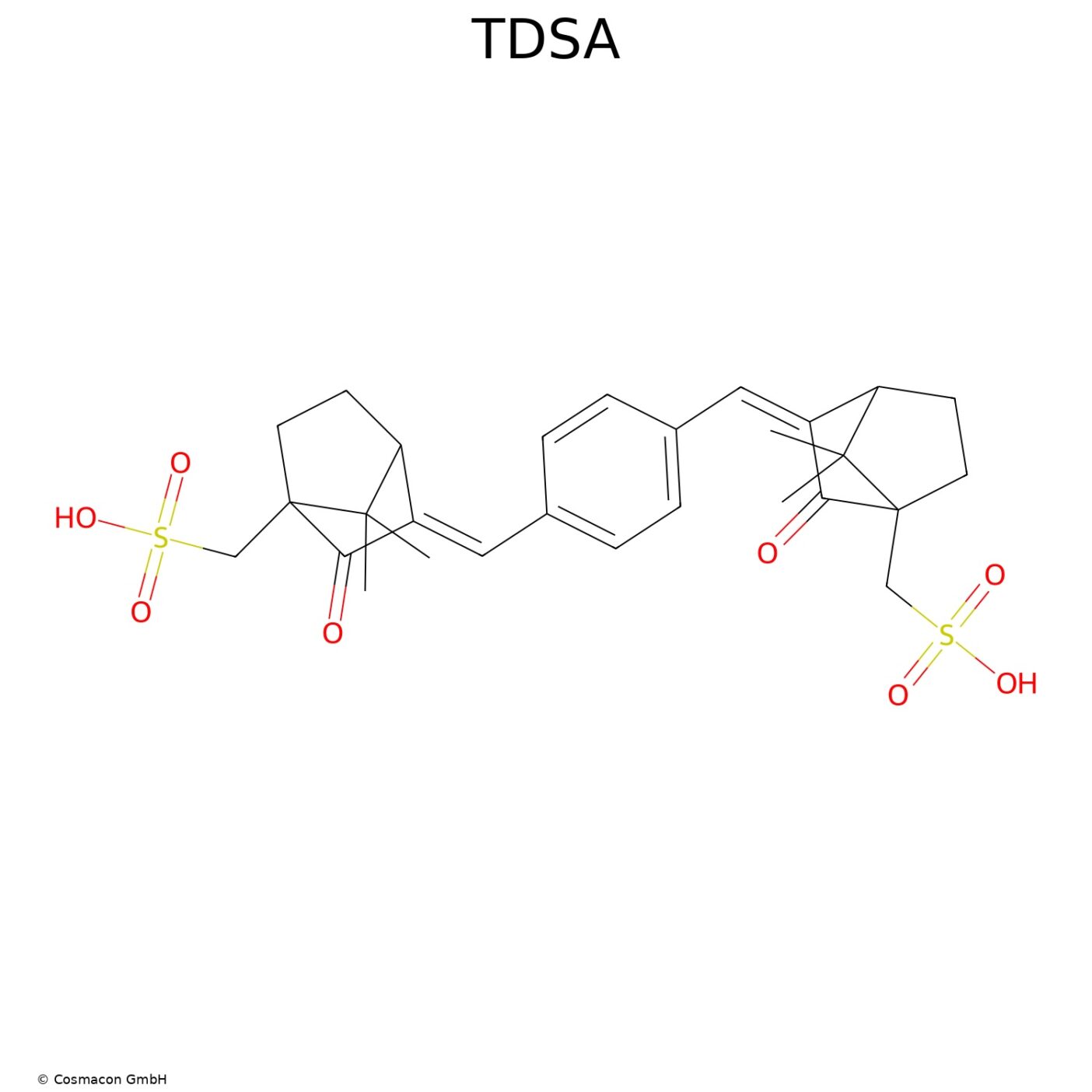TDSA UV filter for light sunscreen formulations

Regulatory requirements, increasing sustainability demands and the desire for pleasant textures make the development of sunscreen products more complex than ever before. This is exactly where the TDSA (Terephthalylidene Dicamphor Sulfonic Acid) UV filter comes in. As a hydrophilic broad-spectrum filter, it opens up new possibilities for effective, photostable and sensorially light concepts – from everyday products to beach products.
Chemical properties and physical-chemical characteristics
TDSA is a hydrophilic molecule with a molecular weight of approximately 563 g/mol, which suggests low skin penetration. It has two sulfonic acid groups that make it water-soluble and shows its maximum absorption at around 345 nanometres in the UVA range. The filter can be easily incorporated into water when neutralised (e.g. with tromethamine or arginine) and has a high molar extinction, making it a particularly efficient UVA filter. The ideal pH range for stability and solubility is around 5.0–5.5.
Photostability and synergy
The TDSA UV filter exhibits excellent photostability, especially in combination with lipophilic broad-spectrum filters. Its ability to effectively absorb UVA radiation perfectly complements other UVB filters, making it an important component of hybrid systems.
Light textures, better film homogeneity
Its placement in the water phase allows the oil phase and oil-soluble filters to be reduced. The result is light, non-greasy textures that absorb quickly and leave the skin feeling pleasant. At the same time, the TDSA UV filter helps to close gaps in UV protection and improve film homogeneity on the skin.
Possibilities with the TDSA UV filter
– Development of daily wear lotions with high UVA protection and a light sensory experience.
– Gel creams and serums that offer a modern skin feel thanks to the water-soluble filter.
– Sprays and sports fluids that offer high protection with maximum application comfort.
– Formulations for children and sensitive skin that rely on particularly mild systems.
Challenges in practice
The TDSA UV filter requires a precise pH window to remain stable and completely dissolved.
It must be incorporated with suitable neutralising agents, as inorganic bases can cause recrystallisation.
Balancing it with oily co-filters requires expertise to optimally balance stability, homogeneity and feel.
Formulation guidelines
Combinations of the UV filter TDSA in the water phase with BEMT, DHHB or EHT in the oil phase deliver broad-spectrum, photostable systems.
Even small amounts (approx. 1%) of TDSA can significantly increase the SPF and improve UVA coverage.
The use of TDSA allows oil phases to be significantly reduced without compromising the protective effect – a clear advantage for modern, lightweight systems.
Conclusion
The TDSA UV filter combines the key properties of modern sun protection systems: high efficiency, good photostability, skin friendliness and the ability to create light, elegant textures. This makes it a key ingredient for the next generation of sun protection formulations.
Would you like to develop lightweight, highly effective sun protection formulations with the TDSA UV filter – from daily sun protection to sprays?
Cosmacon supports you with targeted filter architecture, stability design and sensor optimisation – from the initial idea to efficacy documentation.
With Tojo Cosmetics, you also have access to immediately available private label sunscreen products for fast market entry.
Contact us – we’ll get your sunscreen innovation on the market in time for the season!
Literature:
- TDSA UV filter from the SOFW issue (7+8/2025, p. 24ff.)
- Abid et al. (2017):Photo-stability and photo-sensitizing characterization of selected sunscreen ingredients
Journal of Photochemistry and Photobiology A: Chemistry, Vol. 346, S. 241–250
https://doi.org/10.1016/j.jphotochem.2017.05.020 - L’Alloret et al. (2012):New combination of ultraviolet absorbers in an oily emollient increases sunscreens efficacy and photostability
Dermatologic Therapy, Vol. 25, S. 510–518 https://doi.org/10.1111/j.1529-8019.2012.01492.x